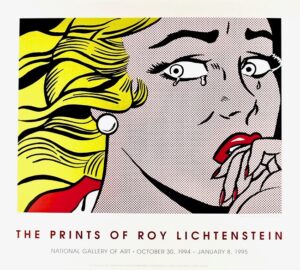A Timeline of 20th Century Art

“Crying Girl” Serigraphed Poster by Roy Lichtenstein, printed by Zimmerman Editions, Ltd.
One way to appreciate this period of time is through the artwork which emerged, expressing the spirit of each decade. There is a proliferation of art movements during the 20th century, each decade reflecting the previous years and building on them. Below is a brief timeline of 20th century art, depicting when each major art movement first appeared.
Early 1900s-1920s
Impressionism had colored the end of the 19th century, but this particular art form would give way to several branches of art at the turn of the century, namely Fauvism, Expressionism, Cubism, and Futurism. Each of these styles enhanced the Impressionist movement by emphasizing different aspects of it. Fauvism used bright, bold colors, Expressionism emphasized emotion through color and abstraction, Cubism favored geometry, and Futurism had bold movement.
1920s
Slightly before the 1920s, you can see the rise of Dadaism, the art movement through which artists expressed the chaos and futility of WWI. This movement rejected cultural authority and made utilitarian objects into masterpieces. Then came the dawn of Surrealism, an art movement that created abstract, fantastical scenes and images. Surrealism harkened back to realism, but in the form of bizarre, unrealistic pictures that aimed to capture the psychological in physical form. A third style that arose in the 1920s was Kinetic art, which brought the viewer into active participation by using various perspectives within a painting. An image might change when moving side to side. Later in the century, Yaacov Agam and Len Janklow became two famous kinetic artists who took this form of expression to higher levels, by allowing the viewer to physically manipulate the artwork created different perspectives and different designs.
1940s
Have you ever seen famous paintings that seem to consist of nothing more than multiple lines and colors? That would be Abstract Expressionism, which was popular from the 1940s to 1960s in the fine art world. This post-war movement originated from the United States and continues to be an appealing art form today.
1950s
Pop Art became popular in the United States and Britain in the 50s and 60s. It took its inspiration from the seemingly trivial art styles of comic books, advertisements, and magazines to create a new form of “fine art.” This style was a vessel for cultural and political commentary. Roy Lichtenstein work typifies Pop Art of the era.
1960s
Minimalism is an art form that continues to be attractive in various pockets of interior design today. This movement arose out of New York. It consists of mainly simple lines, shapes, and colors and takes abstraction to its extreme.
1980s
Postmodernism is perhaps a combination of various styles that came before it. It borrows from Dadaism and Expressionism to create works that depict a philosophical response to the times.
Contact Zimmerman Fine Art Today!
Since 1979 Zimmerman Editions Ltd. has worked closely with many internationally acclaimed artists to execute editions of their most unique images. Collaborating directly with the artists, Zimmerman Editions’ atelier has printed, fabricated, and published many special limited editions of fine art, including both prints and sculptures. All images have been faithfully produced to meet the artists’ most exacting requirements. Many of these high-quality art prints and objets d’art are represented in public and private collections around the world.
If you are a fine art dealer or marketer, or interested in collecting contemporary fine art, contact us today through our short form or phone us at 888-484-1850. For more about fine art, keep in touch through Facebook, Twitter, and LinkedIn!
